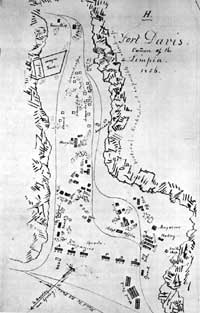|
FORT DAVIS National Historic Site |
 |
Stagecoaching on the Lower Road
IN 1853 THE EL PASO ROAD BECAME part of a Federal mail route connecting San Antonio with Santa Fe by way of Franklin and El Paso del Norte. The contract went to George H. Giddings, who was destined to make an impressive reputation in Texas stagecoaching. At first Giddings carried the mail by mule, but before long he inaugurated passenger service, too. His mail train consisted of two wagons for the mail and an ambulance for passengers, each vehicle drawn by four mules and leading a fifth. The mules made the entire run without relief. The train halted each night at 10 o'clock and resumed the journey at 4 the next morning, pausing for meals at 8 a.m. and 3 p.m. Passengers paid $100 for the trip to El Paso. They were allowed 40 pounds of baggage and, advertised Giddings, "are not required to stand guard." This function was performed by six men, former Texas Rangers, each of whom carried a Sharp's rifle and a Colt's revolver. "They had so much the appearance of drunken ruffians," observed a traveler in 1854, "that we felt no disposition to join the party." Between 1854 and 1857 the Giddings coaches paused at Fort Davis each month. During this period, too, the Army operated a monthly military express between San Antonio and Fort Davis.
In 1857 James Birch won a Federal contract for carrying the mail between San Antonio and San Diego, Calif. At first using wagons, the company soon had coaches providing semimonthly service to the Pacific. As general superintendent, Birch appointed I. C. Woods, who in turn selected George H. Giddings as agent for the eastern division, San Antonio to El Paso. Although Giddings pooled his stock and equipment with those of the Birch line, he continued to operate between El Paso and Santa Fe under his own contract. The Birch coaches, captained by such frontier figures as Giddings, Thomas McCall, Henry Skillman, and "Big Foot" Wallace, stopped at Fort Davis twice a month until 1858, when weekly service was inaugurated.
Within a year the rival and more famous Butterfield Overland Mail, St. Louis to San Francisco, had moved in on Birch's territory, duplicating his route between El Paso and Fort Yuma, Calif. In Texas the Butterfield Trail struck the Upper Road on the Pecos and followed it through the Guadalupe Mountains to El Paso. Water on this trail proved scarce, however, and in 1859 Butterfield moved south, crossing the Pecos by ferry at Horsehead Crossing and reaching El Paso on the Lower Road by way of Fort Davis. Here the company built a station a half mile northeast of the post. From 1859 to 1861, when both Butterfield and the Birch line discontinued service, the two companies operated through Fort Davis.
To Apaches and Comanches, the stagecoaches were inviting prey. They carried fewer defenders than most freight trains and made their way across Texas with predictable regularity. Giddings recalled an event illustrating the danger that threatened the coaches on the San Antonio-El Paso run:
As I was crossing the Escondido about nine miles from Fort Davis our party was attacked. There were two men besides myself in the coach. Jim Spears, the driver, and a contractor named Parker Burnham were on the box. The Indians had no guns, but used bows and arrows exclusively. One of these missiles struck Burnham in the neck. Jim Spears placed the wounded man in the boot of the compartment in the rear of coach. The six horses attached to the stage were then given their heads and ran all the way to Fort Davis, the Indians following close to the post. The coach was filled with arrows which they shot into it and which stuck in it. We kept up a steady fire from our revolvers at them, but I do not know how many, if any, we killed or wounded. . . . One of our horses dropped dead, just as we pulled up at Fort Davis Post Office.
A. D. Richardson, who rode a Butterfield stage across the country in 1859, recorded an incident that occurred in Wild Rose Pass north of Fort Davis. Apaches waylaid a Birch mail wagon, killed the guard, and made off with the mail. They stopped to examine the loot and, discovering a bundle of illustrated newspapers, grew so absorbed in the engravings that they allowed themselves to be surprised by a pursuing detachment of soldiers. Caught off balance, the war party lost 14 men. The survivors, convinced that the pictures had somehow led to their punishment, thereafter avoided them with superstitious fear.
With the El Paso road an important Federal mail route, the Army increasingly felt an obligation to protect it. Brig. Gen. David E. Twiggs voiced the sentiment of most commanders of the Department of Texas when he lamented in 1858:
The road from this [San Antonio] to El Paso is travelled almost daily, and large amounts of property transported on packs and trains. The San Diego mail makes two trips a month to San Diego from this place. It is important that this road be well guarded, but I have not the force to do it.
Nor did he ever get the force to do it. By the close of the 1850's, the Army had made little real progress in destroying the Indian barrier of West Texas.

|
| History | Links to the Past | National Park Service | Search | Contact |
|
Last Modified: Fri, Oct 18 2002 10:00:00 pm PDT |



